When we embark on a circumambulation of a temple (pradakshina), our eyes come across many
figures besides those of the gods and the goddesses. Among the ones we most
frequently meet are the chubby ganas
busy blowing into conch shells, or bearing heavy loads of the temple, or
sometimes playing the musical instruments. Others that we cannot miss are the mithuna couples (erotic art), and
beautiful apsaras (celestial
dancers); while the Gandharvas (celestial musicians) and Vidyadharas (celestial figures that dispel ignorance with their
sword of knowledge) make less frequent appearances. Quite often we also notice
the motifs of a hamsa or a swan going
around the temple walls, marching along like soldiers or sometimes even teasing
the round ganas.
As we look at these images repeated in almost all temples,
the figures automatically turn into an integral part of the temple
architecture, embedding themselves deep into our inner consciousness, so we
accept them unquestioningly. Being a part of the temple walls, these figures or
images also acquire a divinity of their own in the mind of a bhakt, as he
or she completes the pradakshina with thoughts focused on the divine presence
inside the garbagriha.
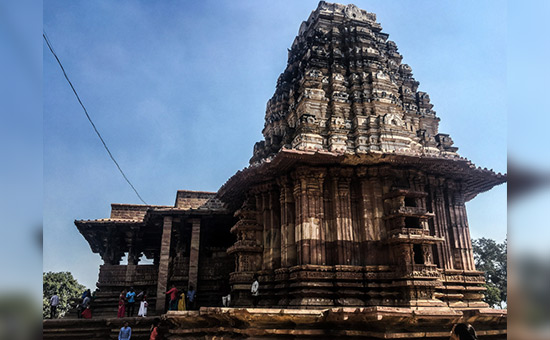 The Ramappa Temple.
The Ramappa Temple.
The Airy Spirits and Breath
Vidyadharas, Gandharvas, Apsaras, Ganas
and Hamsas
According to the rules laid by Shilpa
Shastra, certain murtis have their positions fixed on the temple
walls, spread radially from the main deity stationed inside the garbagriha.
Such murtis can be divided into two categories: the prasar-devtas, which are
the various forms or aspects (rupa) of the main divinity residing inside the
sanctum; and the ashta
dikapalas or gods of the eight cardinal directions, whose
places are fixed in predetermined niches/positions on the temple walls.
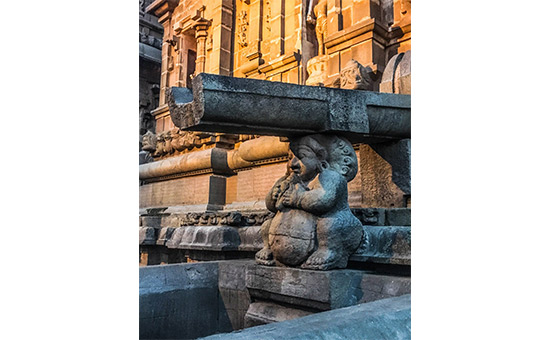 A gana, full of air, blows into a conch shell, producing a sound that is inherent in the air around us (Brihadeswara temple, Tanjore)
A gana, full of air, blows into a conch shell, producing a sound that is inherent in the air around us (Brihadeswara temple, Tanjore)
Between the fixed images there are spread various other
celestial figures, such as the apsaras, gandharvas, etc., and among them the
ones that amuse me the most are the little ganas. The ganas, as
Kramrisch would let us know, are the imagery representations of air, which is
one among the five essential elements that make a human body (panchamahabhutas-
air, water, earth, fire, and ether ); and as we know, it is the air
that summarily supports all our bodily movements.
As India understands better through images, the temple
stapahtis had given a body (an image) to Air and we see that in the form of
ganas, which in a literal sense are mere quantities (gana when
translated denotes a quantity). Shown as potbellied to make them appear full of
air, the little fat airbags or ganas rush around lending a shoulder to a heavy
structure, such as a pillar or the shikhara; or playing musical instruments;
and sometime blowing into the conch-shell.
Airy, full of life, yet in reality body less, the
ganas are also a symbolic representation of the lightness of a mind in full
concentration focused on becoming one with the Brahman or Paramatma.
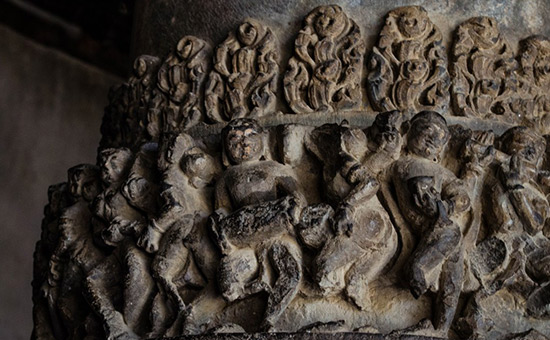 Apsaras and Gandharvas (Neelkanth
temple. Alwar)
Apsaras and Gandharvas (Neelkanth
temple. Alwar)
The Apsaras, the Gandharvas,
and the Vidyadharas represent airy spirits; their bodies made of airy substances that show the five attributes of air, such as running, jumping, stretching, bending, etc. Thus, we see Apsaras performing the heavenly dances in the city of Amaravati, while Gandharvas playing heavenly music there. The Vidyadharas who are not a part of the musical soirée are often depicted as flying alone, or sometimes with Apsaras. They soar lightly across, carrying the sword of knowledge, which they use to cut through clouds of ignorance.
Despite the inevitable aggression of time or kaal that
destroys everything, the vidyadharas with a determined detachment of mind, keep
pursuing knowledge relentlessly.
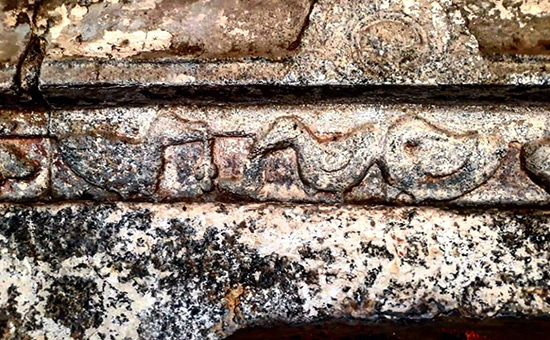 Hamaa bird seen on the walls of Sri Someswara temple, Kolunapaka. Photo credit: Zehra C
Hamaa bird seen on the walls of Sri Someswara temple, Kolunapaka. Photo credit: Zehra C
The geese or swans that
we often see marching on temple walls (they are rarely shown in flight)
represent the breathing rhythm; or Ham-Sa; where HA is the sound of breath
going out, and SA is the sound of air entering the body. The control of breath
which is practiced during Pranayama, is an essential part of Yoga sadhana to
attain the final liberation of the soul. According to Garuda Purana, a person
at any time breathing normally is internally chanting the rhythmic mantra of
Ha-M-sa: Ha-M-Sa. This breath, the essential seed of life, the
pran-beeja, finds an imagery manifestation in the form of Ham-Sa. The
Hamsa bird represents the union point of atma with paramatma, towards which fly
all celestial airy spirits, such as the ganas, gandharvas, and the dancers
(apsaras).
Surasundaris are
a representation of the Sakti, or the passive primordial Energy. They form a
part of the ‘avaran devtas,’ and belong to the air-world or
atmosphere. These female figures are a manifestation of the great beauty of the
Devi, who has for a moment has become conscious of her beauty and is sensing a
deep pride in it, while feeling animated by her sudden passion. Hence, she is
charming and alluring, expressing divine vitality.
Various forms of
Sakti include the Apsaras (often also referred to as Suranganas), Yaksis
also known as Salabhanjikas, and Natakas. Representing
vitality and movement, the Apsaras denote atmospheric
movements, while Yakshis/ Salabhanjikas denote
foliage movements, and Natakas are bodily movements shown in
the form of dancers.
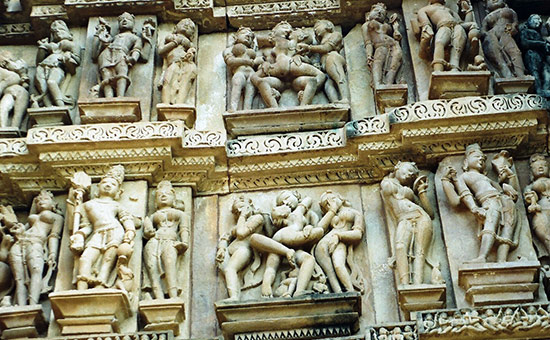 Mithuna couples Khajuraho. Pic by
S Nayyar.
Mithuna couples Khajuraho. Pic by
S Nayyar.
Mithuna
“Embracing Shiva as the Madhava creeper clasps the
young Amra tree with his bosom like cluster of blossoms” – Yogavashishta,
Nirvanaprakarana
Erotica or mithuna couples that we see carved on
temple walls reflect a deeper underlying philosophy than just representing
sensuous earthly pleasures. Deep in the throes of passion the mithuna couples
represent the transition from a physical to the spiritual plane of
consciousness, analogous to the walk from the mandapa to finally meet the
divinity present within the temple embryo or garbhagriha.
In the Vedas, we find the mention of four purusharaths or
human life goals, and one among them is Kama or satisfying
physical pleasure (the other three being Dharma, Artha, and Moksha).
Mithuna sculptures on the temple walls pander to this ancient Hindu philosophy,
which believes that yoga (spiritual exercise) and
bhoga (physical pleasure) are the two paths that lead to
moksha (final liberation).
As Kramrisch explains, when a man is embraced by the
woman he loves he becomes unaware of everything else, inside or outside;
something similar happens when the spiritual being of a person is embraced by
the all-pervading Supreme Soul. In both instances he forgets everything else
that is external or internal to his being. He is satiated, has nothing more to
ask for, and becomes free from all pain, and one experiences unending
happiness, a state of sadaa-sukham.
Thus, mithuna becomes a reflection
of the other purusharath: Moksha, where there is a union of two
inseparable substances, the Purusha (essence or mind) and Prakriti (Sakti or
energy); hence we find Shiva needs Sakti for the final release or moksha,
the ultimate objective of life.
Essentially, the mithuna
couples are thus an imagery representation of that particular moment when
an atma becomes one with the Paramatma, and
enters a state of eternal bliss and ecstasy.
This form of
ritual (used for mastering the third purusharath or kama through bhoga) is
practiced in Tantric worship, and it is for this reason we find gods and
ascetics also shown in mithuna postures in some temples. This form of krida
or lila, however has nothing to do with human copulation that aims at
procreation. The love sport of ascetics, which can be practiced only by
sanyasis (who have already crossed the first two levels of sadhana), with a
woman who willingly gives herself just as a “creeper lovingly embraces a tree.”
This form of lila or krida has no connections to dharma, artha,
or kama, and strictly aims at achieving the fourth
purusharath, moksha. The Avadhuta (one of the highest among
sanyasis in terms of metaphysical realisations, who is above all castes and
social norms) doesn’t need this union with a woman. He is already one with the
Supreme entity: the Brahman.
**There is another perspective or line of thought that
believes the mithuna sculptures on temple walls represent
just what it shows: mithuna; or in other words it just
shows Kama (one among the four purusharths),
and nothing more. A part of the daily life, it represents physical pleasure,
which one must see to overcome earthly temptations before viewing the divinity
present inside the garbagriha or sanctum. Keeping this perspective in mind, I
will say that arguments on this topic can be unending without any convergence
of ideas. Symbolism will perhaps depend to a certain extent on the viewer to
interpret what he sees and what he wants to see.
Speaking for myself, I will side with Kramrisch and
choose to see mithuna sculptures as reflecting the moment of ecstasy, which one
experiences with final liberation or Moksha, when the
antaratma unites with the Paramatma to become one.
The prasara-devtas which are various forms of the main
divinity inside the temple, guide and help us to focus on the Supreme Soul
residing in the sanctum. On the other hand these semi divinities like the
ganas, gandharvas, apsaras, vidyadharas, and the mithuna couples constantly
remind us of our sole objective in life: to become one with the Paramatma and
attain final liberation or moksha.
Thus, from that perspective the temple with all its
sculptures also turns into a point of union of the soul with the Supreme Soul;
an imagery concept or a representation of ecstasy through final liberation or
moksha.
Author studies life sciences, geography, art and international relationships. She
loves exploring and documenting Indic Heritage. Being a student of history she
likes to study the iconography behind various temple sculptures. She is a
well-known columnist - history and travel writer. Or read
here
References
1. Tarun Chopra, 2016. Temples of India. Thompson
Press, Delhi.
2. Stella Kramrisch, 2015. The Hindu temple.
MBP Private Ltd, Delhi.
Article
was first published on author’s blog and here
Article and pictures are courtesy and copyright author.